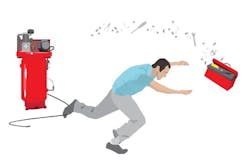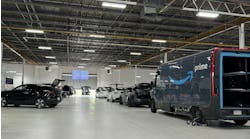When Debbie Moore joined a 20 Group through her paint company, she quickly saw that she was paying far more than other shops in insurance premiums.
So Moore, who co-owns Diamond Collision Services Inc. in Avon, Ind., decided to shop around for better rates. She found one through Associated Insurance Agencies, a sponsor of the Indiana Auto Body Association, of which she’s a member. The new deal ended up saving her $4,000 a year in workers’ compensation costs.
It’s not just Moore who has been paying too much for workers’ compensation. Peter Zaidel, environmental and safety products manager at compliance consulting company KPA, says premiums have risen drastically in recent years. Prices jumped about 10 percent in 2009, and after staying flat in 2010, they rose another 10 percent in 2011. He says the recession caused a spike, and then insurers rose premiums to offset the cost of health care reform.
An average shop with six to eight employees pays a premium of roughly $7,500 to $10,000 today.
“Five-thousand dollars extra right on top of that can hurt you if you’re a small business,” Zaidel says.
FenderBender tapped Zaidel and Bob Mucci, an agent and one of the owners at Collision Select, which specializes in auto body and garage insurance, to get their top tips on how collision repair shops can reduce their workers’ compensation premium costs.
1. Start a safety training program. Most insurance companies will give shops a discount of anywhere from 10 to 50 percent for this kind of practice, Zaidel says. Training for new and existing employees can include facility equipment and conditions, OSHA or state health department safety and accident-prevention training, as well as emergency response education. Other specific programs are available, Zaidel says, such as ergonomics training to prevent back injury, and respiratory protection to help painters who may spend time around chemical fumes.
2. Put injured employees back to work. Mucci says it’s a good idea for shops to find something for injured employees to do. The sooner you can get people back to work—even if it’s simply answering phones or filing paperwork—the less the insurance company will be doling out at ultimately the shops’ expense. “For every payment the insurance company makes, the company is writing that down and figuring what they’ll charge for next year as a result,” Zaidel says.
Mucci says some shops get creative about this. For example, he knows of at least one company that couldn’t find anything for the injured employee to do. So he created a partnership with a local nonprofit and “donated” company time by having the employee volunteer during the workday.
3. Review and reduce all open claims at least six months before renewal. Let’s say an employee injures his back while repairing a car, and you think it’s going to cost $100,000 to cover the injury. But then you find out, after the employee visits the doctor, that his back is healing quicker and the doctor bills will be less than anticipated. Report this finding at least six months before your policy renewal. This could save you big bucks on your insurance premium, Mucci says.
4. Prevent as many problems as possible. Zaidel explains that insurance premiums are calculated through a mathematical formula that takes into account something called the experience modifier. The experience modifier is a lot like a credit score; it takes into account the number of claims you’ve had in order to determine your premium rates. The more claims you’ve had, even if they’re small, the more that counts against you. In fact, some shops choose simply to pay for claims out of pocket rather than report them to the insurance company, as that can be cheaper. The difference can be as much as $100,000 more in annual costs, depending on the situation, Zaidel says. He says it can take five years to put claims fully behind you.
5. Don’t overpay on payroll. Each shop’s premium is calculated using its total payroll. However, Mucci says the payroll audit is designed for overpayment.
So, here are a few tips on calculating payroll:
• Remind the auditor calculating your premium totals that companies do not have to pay worker’s compensation on severance pay.
• Keep strict track of overtime. If Stuart makes $10 an hour, but then makes $15 per hour in overtime, the shop doesn’t have to pay worker’s compensation on that $5 extra per hour, Mucci says. Know this detail and you will not overpay on this aspect of your premium.
• Know the limitations on executive pay. When a company executive like a CEO or vice president makes $52,000 per year, the business doesn’t have to pay worker’s compensation past the $52,000 mark, Mucci says. That’s in Massachusetts, anyway; this rule could vary by state, he says. But knowing this rule could definitely save you in premium costs.
6. Identify hazards. You can find safety checklists through OSHA or your state health department and identify potential hazards in the workplace at least once per month. Zaidel says this also contributes to a culture of people who keep safety top of mind. Then when a piece of equipment breaks, potentially causing a hazard, a manager is more likely to be notified, he says.
7. Create employee incentives. Employees feel good when they get rewarded for doing the right thing. For example, create safety bingo, Zaidel suggests. For each day there isn’t an accident, an employee can get a chip, which can lead to a prize. This puts the pressure on workers to have a consistently accident-free workplace.
8. Hire insured subcontractors. Ask any subcontractor that does work for you to provide a certificate of insurance. This could save you hundreds of dollars in premium costs, Mucci says.
9. Hire safety-minded employees. When you call references, be sure to ask questions that will show how safe and diligent a potential employee is. It can make all the difference in the world, Zaidel says.
10. Learn from your mistakes. If an employee does have an accident, investigate why the accident happened. If it’s because of faulty equipment, for example, buy new; if the air hoses caused a walkway hazard, then move them. The idea is to find out the reason behind the mistake and prevent another similar injury from happening.



